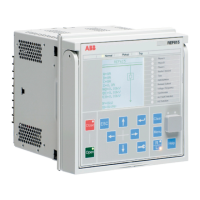4. Application
The feeder protection relay can be supplied either
with directional or non-directional ground-fault
protection. Directional ground-fault protection is
mainly used in isolated neutral or compensated
networks, whereas non-directional ground-fault
protection is intended for directly or low imped-
ance grounded neutral networks. The relay can also
be used for protection of ring-type and meshed
distribution networks as well of radial networks
containing distributed power generation.
The standard configuration D offer non-directional
ground-fault protection for outgoing feeders
equipped with phase current transformers. The re-
sidual current for the ground-fault protection is de-
rived from the phase currents. When applicable, the
core-balance current transformers can be used for
measuring the residual current, especially when
sensitive earth-fault protection is required. The
standard configuration F offer directional ground-
fault protection with phase voltage and residual
voltage measurement. Furthermore, the standard
configuration F include current circuit supervision
and fuse failure supervision for incoming feeders
provided with busbar voltage measurement. In ad-
dition, the standard configuration F offers direc-
tional overcurrent protection, overvoltage and un-
dervoltage protection, positive-sequence
undervoltage and negative sequence overvoltage
protection and residual voltage protection.
The standard configuration L include one conven-
tional residual current (Io) input and three com-
bi-sensor inputs for phase currents and phase volt-
ages. The connection of the three combi-sensors is
made with RJ-45 type connectors. Sensors offer
certain benefits compared to conventional current
and voltage instrument transformers. For example,
current sensors do not saturate at high currents,
they consume less energy and they weigh less. In
voltage sensors the risk of ferro-resonance is elimi-
nated. The sensor inputs also enable the use of the
relay in compact medium voltage switchgears, such
-
icated PT compartments. Further, the adapters also
enable the use of sensors with Twin-BNC
connectors.
The standard configuration L includes directional
overcurrent and directional ground-fault protec-
tion, phase-voltage and frequency based protec-
tion and measurement functions. The analog mea-
surements include one conventional residual
current (Io) input and three combi-sensor inputs
for phase currents and phase voltages. The pro-
vided functionality supports the use of the stan-
dard configuration in power systems, where power
the distribution network. The standard configura-
tion L includes an optional power quality function
which enables monitoring and detecting current
and voltage harmonics and short duration system
disturbances. The standard configuration L also
features an optional impedance-measuring fault lo-
cation function suitable for locating shortcircuits
in radial distribution systems and ground-faults in
effectively and low-resistance earthed networks.
The standard configuration L has been pre-config-
ured especially for ABB switchgear; for example,
-
ration L is however not restricted for switchgears
only but provides the highest functionality level
with sensor inputs for phase currents and phase
voltages. Standard configuration L is not designed
for using all the available functionality content in
one relay at the same time. In order to ensure the
performance of the relay, the user specific configu-
ration load is verified with the Application Configu-
ration tool in PCM600.
15

